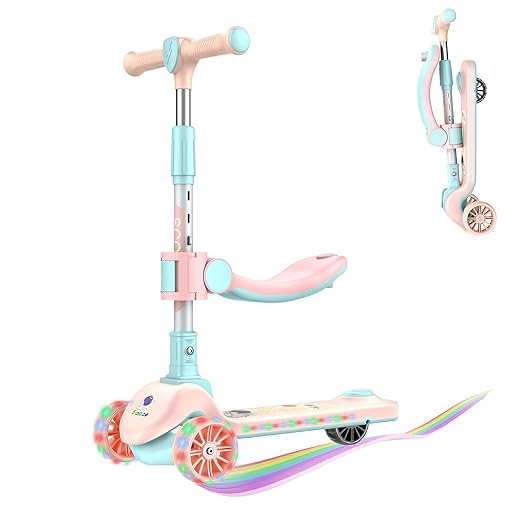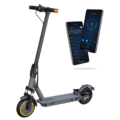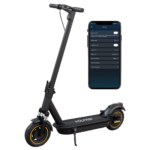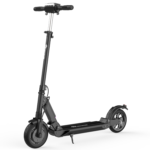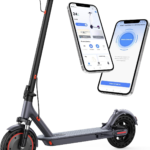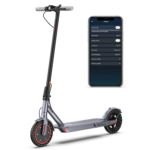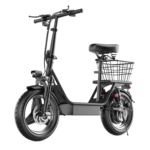- Home
- Scooters
- Electric Scooters
- VOLPAM Kids e-scooter
VOLPAM Kids e-scooter
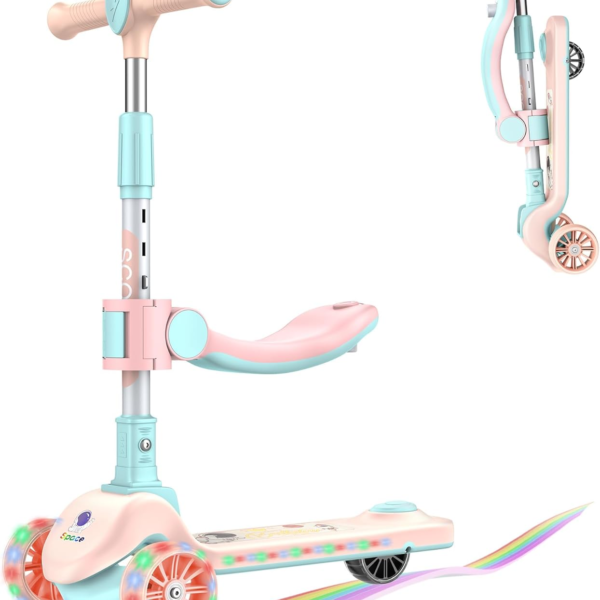

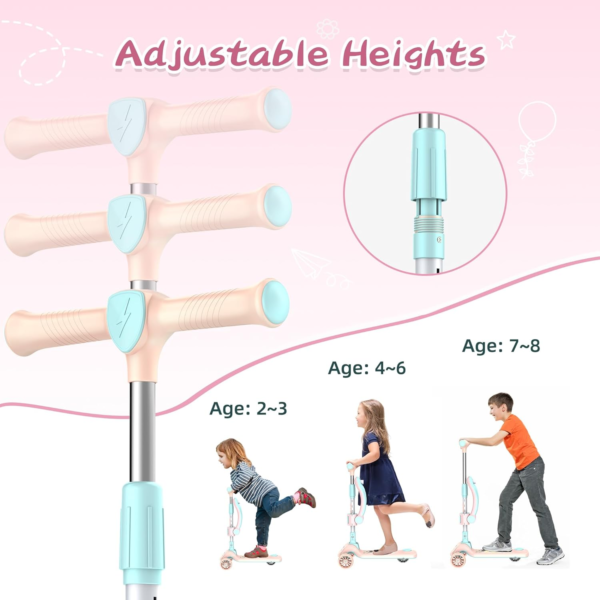
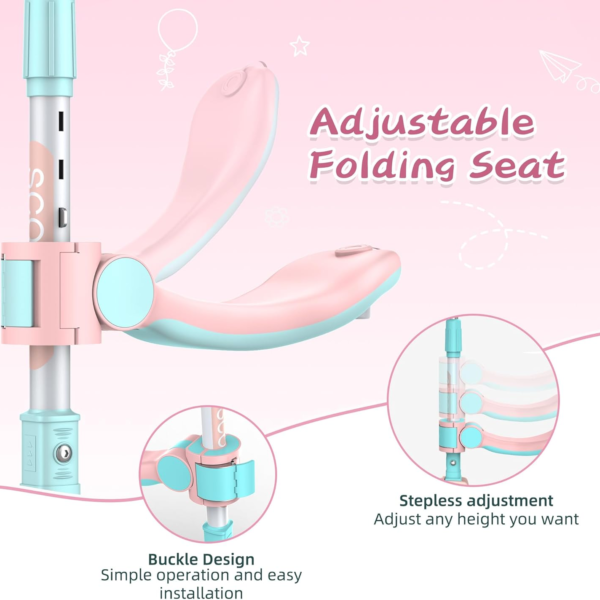
- Battery Range: Not specified
- Top Speed: 10 mph (16 km/h)
- Motor Power: 250 W
- Weight Capacity: 155 lb (70.3 kg)
- Charging Time: Not specified
- Scooter Weight: Not specified
PROS
- 250W motor with 3 speed levels (4/6/10 mph)
- LED display for speed/battery
- Lower deck and manageable size for kids
- Weight capacity up to 155 lb
CONS
- Range not specified
- Brake type not specified
- No app or cruise control listed
- Dimensions not specified
Key Takeaways
- The VOLPAM Kids e-scooter is a compact, kid-sized electric scooter designed for safety and ease of use.
- It features a rear hub motor, foldable stem, and solid 6.5-inch tires with a top speed of 9 mph and a range of up to 5 miles.
- Kids gain confidence with user-friendly controls, while the dual braking system ensures safety during rides.
- The scooter’s lightweight design (17.4 lb) and foldable frame make it easy to store and transport.
- Ideal for young riders seeking short neighborhood rides, but not suitable for older kids wanting higher speeds or for wet conditions.
Table of contents
- What Is the VOLPAM Kids e-scooter?
- How the VOLPAM Kids e-scooter Works
- Key Specifications
- Design & Build Quality
- Performance Fundamentals
- Battery, Range & Efficiency
- Ride Quality & Comfort
- Braking & Safety Features
- Portability & Daily Usability
- Maintenance & Care
- Weather & Seasonal Considerations
- VOLPAM Kids e-scooter vs Alternatives
- Who the VOLPAM Kids e-scooter Is (and Isn’t) For
- FAQs
- Glossary
Small rides can feel big when the gear fits. The VOLPAM Kids e-scooter keeps things light, safe, and simple. It’s small enough for young riders and sturdy enough for daily play. You get easy controls, quick storage, and a gentle learning curve that builds confidence fast.
What Is the VOLPAM Kids e-scooter?
This is a kid-sized electric scooter with a rear hub motor, a foldable stem, and solid 6.5-inch tires. Speed stays in single digits, and range fits park paths and quiet streets. The deck and bars match smaller hands and shorter reach, so control comes naturally. Weight stays low, and that makes it easy for an adult to carry or lift into a trunk. These specs line up with the most common VOLPAM kids model and match what families need day to day.
How the VOLPAM Kids e-scooter Works
Think simple. The thumb throttle asks the controller for power. The controller feeds the rear hub motor. The wheel spins, and the scooter rolls. Press more, go faster. Ease off, slow down.
A lithium-ion battery stores the energy. You plug in a small charger, and the pack fills at a steady pace. The controller manages the charge and discharge so parts run within safe limits.
Braking uses two parts. The electronic brake slows the motor smoothly. The rear fender works as a foot brake and adds extra bite. That mix teaches good habits without drama. Lights help with visibility, and the bar display lets a child switch speed gears and toggle lights. Some units can start from a standstill or need a small kick. Pick the mode that fits your rider and the area.
Key Specifications
Here’s a clean table with the core facts for the VOLPAM kids model. It’s the quick sheet you’ll check for setup, storage, and sizing.
| Block | Item | Value |
|---|---|---|
| General | Model | VOLPAM SR05 (kids electric scooter) |
| Intended rider | Children (youth-size cockpit and deck) | |
| Max load | 132 lb (59.9 kg) | |
| Display | Color display with gear selection and light control | |
| Performance & Power | Motor | 130 W rear hub motor |
| Top speed | Up to 9 mph (14.5 km/h) | |
| Hill climbing | Rated up to 10° slope (about 17% grade) | |
| Ride modes | Multiple speed gears; zero or non-zero start selectable | |
| Battery, Charging & Electrical | Battery type | Lithium-ion (capacity not disclosed) |
| Stated range | Up to 5 miles (8 km) | |
| Charger/charge time | Not specified | |
| Lighting | Colorful LEDs at the rear motor wheel plus user-controlled lights | |
| Build & Dimensions | Tires | 6.5 in (16.5 cm) solid, anti-skid |
| Weight | 17.4 lb (7.9 kg) | |
| Dimensions (unfolded) | 32.7 × 16.1 × 35.0 in (L×W×H) / 83 × 41 × 89 cm | |
| Dimensions (folded) | 35.4 × 16.1 × 12.2 in / 90 × 41 × 31 cm | |
| Deck width | 5.3 in (13.5 cm) | |
| Safety & Control | Brakes | Electronic brake plus rear foot brake |
| IP rating | Not listed | |
| Reflectors/Bell | Not listed | |
| Features & Extras | Fold mechanism | Quick-fold stem for carrying and storage |
| Cruise Control | Not listed for this kids model | |
| Warranty & Compliance | Warranty | 12-month limited warranty |
| Safety compliance | No UL listing noted |
So that’s the snapshot. The sections below turn those numbers into real-world advice.
Design & Build Quality
Everything feels scaled for kids. The deck sits low, and the 5.3-inch width gives solid foot space. Small riders can stand square, bend their knees, and stay stable. The stem folds with one latch. It’s simple for an adult to operate and quick at the curb. Solid tires remove tube chores and punctures, and they keep the scooter ready for spur-of-the-moment rides. The motor wheel’s LEDs add some fun and help drivers see your rider at dusk.
Fit and finish look tidy. Edges are rounded, and the display shows large icons and clear gear steps. Cable runs stay short, and the hub motor keeps the rear end uncluttered. The whole scooter looks compact nose to tail. It slides into a closet or a trunk without fuss.
Performance Fundamentals
Power sits at 130 watts. Starts feel calm with a smooth ramp, and that keeps first-time nerves low. Speed builds to about 9 mph, which is enough for a breeze on the face and not enough to get messy. On flat ground it holds pace. On small slopes it slows in a predictable way, so kids learn to plan ahead.
Short hills around 7–10% may need a kick near the top. That’s normal for small motors. The controller will ease current when load rises, then speed fades a bit. The upside is control. Kids learn to look ahead, keep momentum, and give one strong push when they need it.
Battery, Range & Efficiency
The rated range is five miles, or eight kilometers. Real life varies with rider weight, paved vs packed-dirt paths, and weather. Cold air drops voltage under load. Headwinds drag. Rough surfaces waste energy. So start with two to three-mile loops, watch the battery bar at each stop, and leave a little cushion for the ride home.
Charging is easy. Plug in, wait for the status light, and you’re set. Packs charge faster from low and slow near full. That’s gentle on cells. For longer life, charge close to ride time, and avoid storing the scooter empty. Park it in a dry, cool spot. Heat ages cells. Deep cold shrinks range on the next outing.
Small habits help. Top off after rides. Pick one longer session instead of four micro trips that chase 100%. If you’ll pause for a few weeks, leave the battery around half. Keep the charger where you store the scooter, then charge becomes part of the routine.
Ride Quality & Comfort
Solid 6.5-inch tires keep flats off the table. They ride firm on cracked pavement but feel fine on clean paths. The low deck steadies balance and cuts wobble, and the short reach keeps arms relaxed. Grips are soft and sized for small hands.
Stem flex should be low on a kids model, and it is. The short stem helps the scooter track where you point it. On rougher paths, remind your rider to bend knees and stay centered over the deck. Their legs become light suspension. That one tip makes a big difference in comfort.
Braking & Safety Features
The electronic brake slows the rear hub smoothly. The fender pad works as a foot brake when you need more. Start practice in a quiet lot. Roll, then ease off the throttle, tap electronic brake, and add the foot brake. That order sticks fast and keeps stops predictable.
Lights and the colorful motor-wheel LEDs boost visibility. The display makes it simple to turn lights on and pick a speed gear. There’s no water-resistance rating listed, so treat this as a fair-weather scooter. Skip puddles and wet days. Build a simple pre-ride check: latch locked, tire tread clear, both brakes working. One minute now saves trouble later.
Portability & Daily Usability
At 17.4 lb (7.9 kg), carrying the scooter is easy for an adult. Folded size is 35.4 × 16.1 × 12.2 in, which fits under a bench or behind a seat. The latch closes in one motion, and the bar nests cleanly. For daily life, keep it near the door, and keep the charger close by. Wipe the deck if shoes are wet or sandy, then traction stays sharp.
Trips by car are simple. Lay the scooter deck-down, and tuck the charger in the same bin each time. That tiny bit of order keeps park rides smooth and stress-free.
Maintenance & Care
You don’t need a big toolbox. A short list covers it:
- Before rides (weekly): Check tire tread, close the latch fully, and test both brakes at walking speed.
- After rides: Wipe dust off the deck and rear wheel area. Then top off the battery.
- Monthly: Snug the hinge bolts and bar clamp with a small hex key. Stop at firm. No gorilla torque.
- Each season: Clean the foot-brake surface, clear dirt from the deck seams, and inspect the charger cable.
Solid tires remove tube repair. The electronic brake needs no cable tension. Keep the charger dry and loosely coiled. If a rattle shows up, trace it to a clamp or fender screw and tighten once. That quick fix stops wear from vibration and keeps the scooter quiet.
Weather & Seasonal Considerations
Plan dry rides. There’s no listed IP rating, and water can find its way into places you don’t want it. Puddles hide holes and slick paint. On hot days, store the scooter out of direct sun. On cold days, expect shorter range, then start with a warm battery from indoors and build pace over the first few minutes.
Seasonal traction changes matter. Fall leaves and painted lines get slick. Loose gravel on park paths rolls under hard tires. Slow sooner and stop in a straight line. If shoes or the deck get wet, dry them before the next lap. If wind picks up, drop to a lower gear and shorten the loop.
VOLPAM Kids e-scooter vs Alternatives
Vs a manual kick scooter: Motor help keeps speed steady on flats and gentle slopes. Kids ride longer without tired legs. A kick scooter weighs less and costs less, but it can wear them out on longer loops. If you want a foldable frame with motor assist, this one makes outings easier.
Vs youth scooters with 150–250 W: Bigger motors climb a bit better and may add larger wheels. They feel heavier to carry and can feel big for smaller kids. The VOLPAM stays easy to lift and store. If you’re teaching throttle and brake, the calmer tune helps. If you want an even simpler starter for very young riders, the Hover-1 My First e-scooter is a neat reference point.
Vs entry teen commuters: Teen models add speed headroom, more range, and more braking. They suit older riders who travel farther. They also take more space and weight. For short trips and school-yard laps, this lighter kids model hits the sweet spot. When your child grows and needs a step up, the VOLPAM Q1 offers more headroom without a big learning curve.
Who the VOLPAM Kids e-scooter Is (and Isn’t) For
Great fits
- New riders who want calm throttle and a light frame
- Families planning short neighborhood rides or park loops
- Homes that need a foldable scooter in a tight space
- Parents who prefer low maintenance over extra plush
Not ideal
- Older kids who want 12–15 mph and longer range
- Families that ride in rain or on broken streets
- Riders who live on steep hills or climb often
If your child is starting out and you want safe, simple fun, this model lands right where it should.
FAQs
1) Is the VOLPAM Kids e-scooter adjustable for skill level?
Yes. Pick a speed gear, and choose zero-start or kick-to-start. Set it to match the rider and the route.
2) What range should we expect in real life?
Plan for two to three miles per session. Leave a small buffer for wind, hills, and colder days. The rated figure is five miles.
3) How does the braking feel?
Electronic braking is smooth and quiet. The foot brake adds bite when you need it. Practice the sequence in a quiet lot first.
4) Can kids ride it in light rain?
Skip wet rides. There’s no water-resistance rating listed, so keep it dry and avoid puddles.
5) What maintenance should we do?
Check the latch and brakes weekly, wipe the deck after rides, and snug a few bolts monthly. Solid tires mean no tubes to fix.
6) Does it have Cruise Control?
No. Kids control speed with gears and the throttle. That keeps attention on the basics.
7) Where can I see the “VOLPAM Kids e-scooter overview”?
Right here. This guide walks through what it is, how it rides, and how to care for it.
Glossary
- Ah (amp-hours): How much charge a battery can hold.
- Wh (watt-hours): Energy capacity; voltage times amp-hours.
- Controller: The small box that meters power to the motor.
- Hub motor: A motor built into the wheel hub.
- Electronic brake: Uses the motor to slow the wheel.
- Foot brake: Press the rear fender pad to add stopping force.
- Zero-start: Throttle works from a standstill.
- Kick-to-start: You push first, then the throttle engages.
- Stem: The tube that holds the bar and folds at the hinge.
- Stem flex: Small movement in the stem under load.
- IP rating: Water and dust score; not listed here.
- Deck: The platform for your feet.
- Grade: Hill steepness; 10° is about 17%.
- Solid tire: Rubber tire with no tube.
- UL 2272: A common electrical safety standard.
Specifications
General
| Model The Model specifies the exact version or name of the scooter. It helps identify its unique design, features, and specifications within the manufacturer’s product line. Knowing the model makes it easier to compare options, find compatible accessories, or look up support information. | Kids e-scooter |
| Brand The Brand identifies the manufacturer or company that designs and produces the scooter. A trusted brand is a sign of quality, reliability, and good customer support. Well-known brands often have higher standards for safety, performance, and after-sales service, giving you more confidence in your purchase. | VOLPAM |
| Release Date The Release Date indicates when the scooter model was officially launched on the market. This helps you know how current the design, technology, and features are. A newer release date often means updated components, improved performance, and the latest safety or smart features. | 18 November 2025 |
| Recommended Age Recommended Age indicates the minimum age range that the scooter is designed for, based on safety, size, and ease of use. Following the recommended age helps ensure that riders can handle the scooter’s speed, weight, and controls comfortably and safely. Always check local laws and use protective gear, especially for younger riders. | 8+ |
Performance & Power
| Motor Power (Wattage) What it means: The motor power, measured in watts (W), shows how strong the scooter’s electric motor is. Why it matters: Higher wattage usually means better acceleration, more torque, and improved performance on hills or rough terrain. For example, a 250W motor is good for flat city roads and light riders, while a 500W or 1000W motor provides more power for faster speeds or climbing steep inclines. | 250 W hub motor |
| Top Speed The Top Speed indicates the maximum speed that the scooter can reach under optimal conditions. It’s usually measured on level ground with a fully charged battery and an average rider weight. A higher top speed allows you to travel longer distances faster, but always ensure you ride within legal speed limits and your personal comfort zone for safety. | 10 mph (16 km/h) |
| Battery Capacity Battery Capacity refers to the total amount of energy the scooter’s battery can store, usually measured in ampere-hours (Ah) or watt-hours (Wh). A higher battery capacity means you can ride longer distances on a single charge, reducing the need for frequent recharging. Keep in mind that actual range can vary depending on rider weight, terrain, speed, and weather conditions. | 25.2 V 4.4 Ah (110.9 Wh) |
| Estimated Range per Charge The Estimated Range per Charge indicates the average distance the scooter can travel on a single full battery charge. This range is calculated under optimal conditions, such as flat terrain, moderate speed, and average rider weight. Real-world range may vary depending on riding style, terrain, weather, and load. A longer range means fewer recharges and greater freedom for longer trips. | Not specified |
| Hill Climb Ability Hill Climb Ability describes the maximum incline or slope that the scooter can handle while maintaining stable performance. It’s typically expressed as a percentage or in degrees. A higher hill climb rating means the scooter can tackle steeper hills without losing too much speed or power. Actual climbing performance may vary based on rider weight, battery charge, and terrain conditions. | Not specified |
| Drive System The Drive System refers to how power from the motor is delivered to the wheels. Electric scooters typically use either a hub motor (directly integrated into the wheel) or a chain/belt drive system. A high-quality drive system ensures smooth acceleration, efficient power transfer, and low maintenance. The choice of drive system affects performance, noise level, and overall ride experience. | Not specified |
Charging & Electrical
| Charging Time Charging Time indicates how long it takes to fully recharge the scooter’s battery from empty to 100% using the standard charger provided. Faster charging means less downtime and more time on the road. Actual charging time may vary slightly depending on battery capacity, charger output, and environmental conditions. | Not specified |
| Battery Type Battery Type refers to the specific technology used in the scooter’s battery, which affects performance, lifespan, weight, and charging time. Most modern electric scooters use high-quality lithium-ion (Li-ion) batteries because they offer a good balance of energy density, durability, and low maintenance. A reliable battery type ensures consistent power delivery and longer riding ranges. | Lithium-ion |
| Removable Battery A Removable Battery means the battery pack can be easily detached from the scooter for convenient charging and replacement. This feature allows you to charge the battery separately, swap it with a spare for extended range, or securely store it indoors in extreme weather. Removable batteries add flexibility and make it easier to keep your scooter powered up wherever you are. | Non-removable internal battery |
| Regenerative Braking Regenerative Braking is an energy-saving feature that converts some of the energy normally lost during braking back into battery power. When you slow down or brake, the motor works in reverse to generate electricity, which helps extend the scooter’s range and improves overall efficiency. This system also reduces wear on traditional brake components, leading to lower maintenance over time. | Not specified |
| Lighting Lighting refers to the built-in front and rear lights that enhance visibility and safety when riding in low-light conditions or at night. Good lighting helps you see the road ahead and ensures that other road users can see you. Many scooters include LED headlights, taillights, and sometimes brake lights or side reflectors for added safety and compliance with local traffic regulations. | LED headlight/taillight (where equipped) |
Build & Dimensions
| Scooter Weight Scooter Weight refers to the total weight of the scooter when fully assembled, including the battery. This affects how easy it is to carry, lift, and store the scooter when not in use. A lighter scooter is more portable and convenient for commuting, especially if you need to carry it upstairs or onto public transport. Keep in mind that a sturdy frame and quality components may add to the weight but also contribute to better durability and ride stability. | Not specified |
| Maximum Rider Weight Maximum Rider Weight indicates the highest rider weight that the scooter is designed to safely support while maintaining optimal performance and stability. Staying within this limit helps ensure reliable acceleration, braking, and climbing ability, and it protects the frame, suspension, and motor from excessive strain. Exceeding the recommended limit may reduce performance and increase wear on components. | 155 lb (70.3 kg) |
| Deck Size Deck Size refers to the dimensions of the scooter’s standing platform. A wider and longer deck provides more foot space, allowing you to stand comfortably and adjust your stance while riding. A well-sized deck improves balance and stability, especially on longer rides or at higher speeds. Compact decks, on the other hand, help keep the scooter lightweight and portable. | Compact kids geometry |
| Handlebar Height Handlebar Height refers to the distance from the deck to the handlebars, which affects your riding posture and comfort. An appropriate handlebar height helps you maintain good balance, reduces strain on your back and arms, and makes steering more comfortable. Some scooters have adjustable handlebars to fit riders of different heights, while others have a fixed height for a streamlined design. | Not specified |
| Folding Mechanism The Folding Mechanism describes how easily and securely the scooter can be folded for carrying and storage. A well-designed folding system lets you quickly collapse the scooter into a compact size, making it convenient to transport on public transit, store under a desk, or fit into a car trunk. Look for sturdy latches and safety locks to ensure the scooter stays firmly in place when folded or unfolded. | Folding stem |
| Dimensions Folded Dimensions indicate the size of the scooter when it’s fully folded. This measurement shows how much space the scooter will take up when stored or carried, making it easier to check if it will fit in your car trunk, under a desk, or in a closet. Compact folded dimensions are ideal for commuters who need to bring their scooter on public transport or store it in tight spaces. | Not specified |
| Material Material refers to the primary construction materials used for the scooter’s frame and key components. High-quality materials like aircraft-grade aluminum, reinforced steel, or durable composites provide strength, stability, and a lighter overall weight. A sturdy material ensures the scooter can handle daily wear and tear while maintaining safety and performance. | Not specified |
Safety & Control
| Brake Type(s) Brake Type(s) describe the braking systems the scooter uses to help you slow down or stop safely. Common brake types include mechanical brakes (like drum or disc brakes), electronic brakes, and foot brakes. Many scooters combine multiple braking systems for added safety and shorter stopping distances. The type and quality of brakes affect your control, especially when riding at higher speeds or on slopes. | Not specified |
| Suspension Suspension refers to the system that absorbs shocks and vibrations while riding, providing a smoother and more comfortable ride over uneven or rough surfaces. Scooters may have front suspension, rear suspension, or dual suspension for better shock absorption and stability. Good suspension helps reduce rider fatigue and improves control, especially when riding on bumpy roads or off-road paths. | Not specified |
| Tire Type Tire Type refers to the kind of tires the scooter uses, which directly affects ride comfort, traction, and maintenance. Common types include solid (airless) tires, pneumatic (air-filled) tires, or hybrid options. Pneumatic tires offer better shock absorption and a smoother ride on rough surfaces, while solid tires are puncture-proof and require less upkeep. The right tire type helps ensure safe handling and a comfortable ride in different conditions. | Not specified |
| Tire Size Tire Size indicates the diameter and width of the scooter’s tires, which affect ride comfort, stability, and how well the scooter handles different terrains. Larger tires generally offer better shock absorption and a smoother ride over bumps and rough surfaces, while smaller tires keep the scooter lighter and more portable. Choosing the right tire size helps ensure a balance between agility and comfort. | Not specified |
| Kickstand The Kickstand is a built-in stand that allows you to park your scooter upright when it’s not in use. A sturdy kickstand keeps the scooter stable and prevents it from tipping over, protecting it from scratches and damage. It also makes storing and accessing your scooter more convenient, whether you’re at home, work, or on the go. | Not specified |
| Water Resistance Rating Water Resistance Rating indicates how well the scooter is protected against water and moisture, usually shown as an IP (Ingress Protection) rating. This rating helps you understand whether the scooter can handle light rain, splashes, or wet roads without damage. While most scooters are not fully waterproof, a good water resistance rating adds peace of mind when riding in changing weather conditions. Always avoid deep puddles or submerging the scooter to protect its electrical components. | Not specified |
Features & Extras
| Display/Console The Display (or Console) shows important real-time information about your ride, helping you monitor your scooter’s status at a glance. Typical displays show speed, battery level, distance traveled, and riding mode. Some models also include additional features like Bluetooth connectivity, app integration, or backlighting for better visibility at night. A clear and easy-to-read display enhances safety and convenience on every trip. | LED display |
| Ride Modes Ride Modes refer to the different speed and power settings you can choose to match your riding style or road conditions. Common modes include eco for maximum range and energy efficiency, standard for everyday balance, and sport or turbo for higher speed and stronger acceleration. Switching between ride modes allows you to customize performance, conserve battery, and ride safely in various environments. | 3 speed modes |
| Smart App Connectivity Smart App Connectivity lets you pair your scooter with a dedicated mobile app via Bluetooth. Using the app, you can monitor real-time ride stats like speed, battery level, and range, adjust settings such as ride modes or cruise control, lock the scooter for added security, and sometimes receive firmware updates. This feature adds convenience and allows you to personalize your riding experience right from your smartphone. | No |
| Anti-Theft System The Anti-Theft System helps protect your scooter from unauthorized use or theft. This feature can include built-in alarms, electronic motor locks, GPS tracking, or remote locking through a mobile app. A good anti-theft system provides peace of mind when parking your scooter in public spaces, adding an extra layer of security to safeguard your investment. | Not specified |
| Cruise Control Cruise Control allows you to maintain a steady speed without continuously holding the throttle. This feature makes longer rides more comfortable by reducing hand fatigue and providing a smoother, more relaxed riding experience — especially on flat, open roads or bike lanes. For safety, cruise control can usually be easily activated or deactivated while riding. | No |
| Accessories Included Accessories Included lists the additional items that come with the scooter to enhance your riding experience and convenience. Common accessories may include a charger, kickstand, bell, lights, phone holder, or carrying strap. These extras add value by making your scooter safer, easier to use, and ready to ride straight out of the box. | Not specified |
Warranty & Compliance
| Warranty Period The Warranty Period indicates how long the manufacturer guarantees the scooter against defects in materials and workmanship under normal use. A good warranty provides peace of mind, showing the brand’s confidence in its product quality. Always check what parts are covered, such as the frame, battery, and motor, and follow the maintenance guidelines to keep your warranty valid. | 12 months (region-dependent) |
| Certifications Certifications confirm that the scooter meets specific safety, quality, and environmental standards set by recognized organizations or regulatory bodies. Common certifications may include CE, RoHS, UL, or other local compliance marks, depending on your region. These certifications ensure that the scooter is manufactured to high standards and is safe and legal to use in your country. | Region-dependent |



